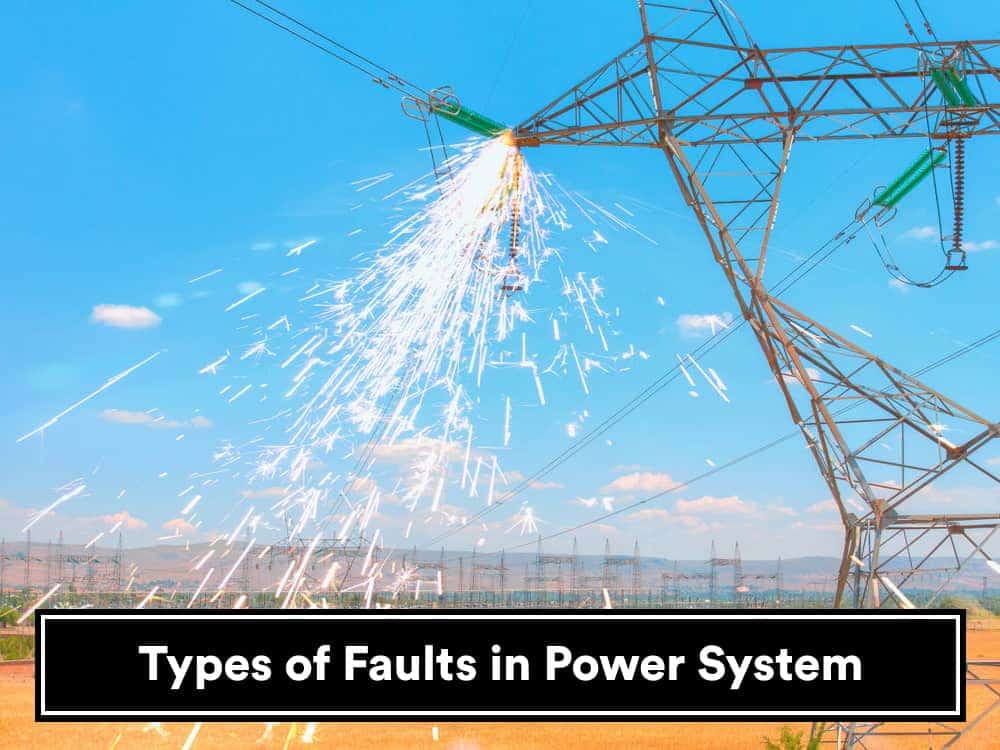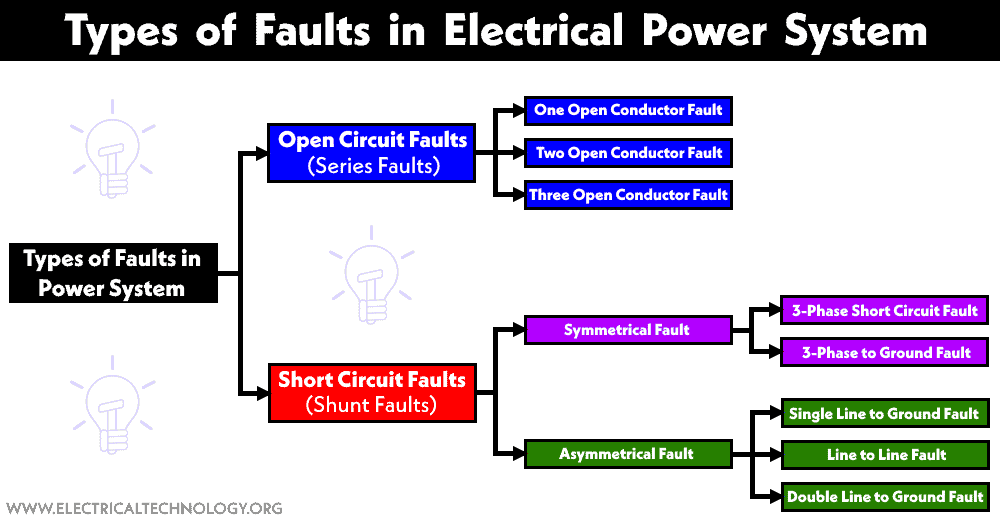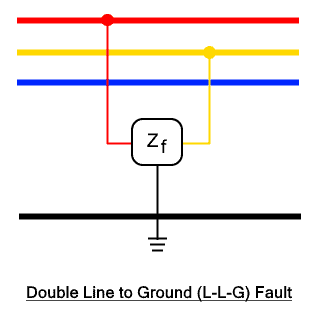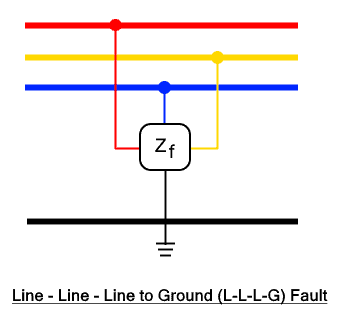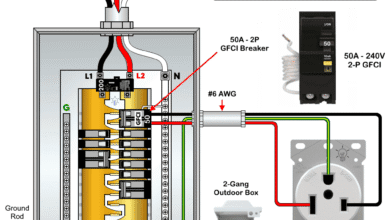Types of Faults in Electrical Power System
Different Types of Faults in Power Systems. Causes & Effects, Severity & Occurrence and Fault Protection Devices
In modern days, we cannot imagine our daily life without electricity. Our homes, offices and the industrial sector run on electricity. The electrical systems are designed to operate safely and smoothly using different sets of electrical codes and standards to eliminate the risk factor of faults occurrence.
However, due to various natural and man-made conditions, faults can occur in the electrical system. These electrical faults can create hazards for living things as well as damage expensive equipment and the building.
There are different kinds of faults that can appear in any electrical system. This article briefly explains the types of faults in electrical systems.
What is an Electrical Fault?
An electrical fault is a condition in which abnormal levels of voltage and current are introduced into the electrical system. The abnormalities in an electrical system that causes unwanted current is called an electrical fault. The current in such a condition is called fault current.
In normal conditions, an electrical system operates at nominal current and voltage values. During an electrical fault, the current and voltage level diverges from the nominal range into the abnormal range.
The electrical fault reduces the insulation strength of the conductors causing a short circuit and damaging the equipment and appliances. It can create a short circuit, open circuit, overcurrent, Undervoltage, overvoltage, reverse power and unbalance in the phases.
Types of Fault in Electrical System
There are different types of Faults in electrical systems classified based on their condition.
Transient Fault
A transient Fault or temporary fault is a type of fault that only occurs for a short period of time and the system resumes its normal operation after a short duration of time. The fault can be cleared on its own or by disconnecting the power supply momentarily. These faults won’t permanently damage the electrical system.
Overhead power lines experience transient fault very often. Examples of transient faults are lightning strikes, bird contact, and conductor collision. These faults affect the point of origin as well as the connected electrical circuit due to the fault current. These faults do not interrupt the normal operation of the electrical system.
Persistent Fault
Persistent or permanent faults are a type of fault that is present regardless of the disconnection of the power supply. These faults do not clear on their own but require other safety equipment to break the power supply and require human intervention to clear the fault.
Permanent faults mostly occur in underground cables. Overhead lines experience permanent fault due to weather conditions, trees falling on power lines, sagging, etc.
Active Fault
The active fault is a type of electrical fault when the current flow between two phase conductors or phase and ground conductor. This fault occurs due to the unwanted flow of active current. There are two types of active faults
- Solid Fault
- Incipient Fault
Solid Fault
The solid fault is a type of active fault that occurs due to the complete breakdown of the conductor insulation or breaking of the conductor itself. As a result, the conductors come into contact with each other.
Solid faults mostly occur in underground power cables and overhead power lines. The underground cables experience high pressure from the heavy machinery working above them. The power lines break due to extreme weather conditions and accidents.
The solid fault must be removed as soon as possible as it can cause severe damage at the location of the fault and very heavy power loss. The fault location becomes hazardous for any personnel working at the spot.
Incipient Fault
Such type of active fault starts with a low magnitude and gradually increases with time into a solid fault or emergency situation. Incipient faults at their initial stage is a low-level fault such as discharge that eventually becomes solid fault.
Related Posts:
- Failures In Electrical Systems, Equipment & Materials
- All About Electrical Protection Systems, Devices And Units
Passive Fault
Passive faults are faults that are described as a condition rather than an actual fault. These are such conditions in which the electrical system is operated at electrical parameters that are beyond its design capabilities.
Some of the passive faults are described below
Overloading
Electrical overloading is the condition when current several times larger than the nominal current is introduced in the electrical system but is confined in its normal path. The overloading current damages the insulation over a period of time. Transient or momentary overloads do not cause damage but continuous overloading can eventually create a short circuit.
Every electrical system is designed to safely carry current that is within its operating range. If the current exceeds this range, it heats up the wires and causes fire.
The overload can occur due to connecting too many loads in a single circuit, damaged equipment or electrical components in a circuit, inrush current of a motor, connecting heavy load, or worn bearing of the machine.
Overvoltage
As the name suggests it is a condition in which the operating voltage rises above the nominal or the rated maximum voltage of the system. The rise in voltage can be momentary as in a voltage spike or permanent. The overvoltage cause a large current to flow in a circuit that heats up the wires. Similarly, overvoltage can blow electrical devices and components and sometimes cause an electrical fire.
Overvoltage can occur due to a lightning strike but that is transient in nature. Switching on/off an inductive load can also cause an overvoltage spike in the connected electrical system. Huge current changes can also create voltage spikes.
Power Swing
In an electrical system, the amount of power generation and power consumption at any point in time is equal. But with a sudden increase or decrease in load, the power generation has to be adjusted. But due to inertia, the power generation cannot be instantly adjusted. Therefore the power oscillates (varies continuously) throughout the network. This fault is called a power swing.
These power oscillations are normally damped. These power swings can cause the malfunction of a protective relay. Therefore, the relay operation must be blocked by detecting the condition first.
Bolted Fault
A bolted Fault is a short circuit fault between all the phase conductors and the earth conductor as if connected by a metal bar. It has zero fault resistance and maximum possible fault current.
A bolted fault is highly unlikely to occur but it is deliberately introduced in a system to test and select appropriate protection devices.
Overcurrent
Overcurrent fault is the sudden increase in the current that occurs due to a short circuit or corona discharge between live conductors. It is similar to an active fault. Overcurrent may occur due to overloading of the power source. In order to avoid this fault overcurrent relays, circuit breakers and fuses are used.
Under voltage
In under voltage fault, the voltage decreases below the operating range. It occurs due to the failure of the alternator field or due to the increased voltage drop across the machine or due to heavy load on a utility transformer.
Undervoltage can damage or reduce the life of the equipment. For such faults, Undervoltage protection relay is used that continuously monitors the voltage and breaks the supply in the event of Undervoltage.
Unbalance Fault
Am unbalance fault occurs when there is a fault in one or two of the three phases. It results in an imbalance in the current flowing through the conductors. Unbalance fault can occur due to a short circuit between two phases or single or double broken conductors.
Reverse Power
In an electrical system, there can be more than one power source running at a time such as a generator in parallel with other utilities. In case the generator output falls which may happen due to the prime mover not supplying enough torque to the rotor, the generator will start to draw power from the bus bar and behave like a motor.
This is why it is also known as the motoring effect. It can overload the other source and causes total power failure. A reverse power protection relay which is a directional relay is used for protection against reverse power.
Ground or Earth Fault
Ground or earth fault is a fault that occurs when an energized or live conductor comes into contact with the ground or earth conductor. The current goes through an unintended path and returns to the ground. It can occur due to insulation failure, overloading, or extreme weather conditions.
The fault results in a very large fault current that can damage the equipment and it can cause electrical shock to any person. GFCI (Ground Fault Circuit Interrupter) is used for protection against ground fault.
Related Posts:
- Power Transformer Protection and Faults
- Transformers Fire Protection System – Causes, Types & Requirements
Arc Fault
An arc fault is a powerful electrical discharge between two or more than two conductors. The arc can vary in strength depending on its current ratings and duration. It can generate enough heat to break the insulation and cause an electrical fire. The arc also generates waveforms that can disrupt or destroy sensitive electronics equipment.
An arc fault can occur between two phase conductors or between a phase and earth conductors. It can occur due to loose connections, overheated wires, worn insulation, corroded terminals, etc.
In order to protect against arc fault, AFCI (Arc Fault Circuit Interrupter) is used.
The faults in electrical power systems can be briefly classified into two types
- Open Circuit Fault
- Closed Circuit Fault
Open Circuit Fault
Open Circuit Fault occurs due to failure in one or more than one phase conductors. It is a series of faults that occur due to damaged or broken conductors. The connected circuit experiences an imbalance in the current flowing through it and causes equipment failure.
Open circuit faults can be classified into types.
- One Open Conductor Fault
- Two Open Conductors Fault
- Three Open Conductors Fault
An open circuit fault is an asymmetrical fault that causes an imbalance in the system except for the three open conductor faults. The phase conductor may break due to loose joints, trees falling over the power lines in extreme weather conditions, fuse breaking in one or more than one phase, circuit breaker breaking in one phase, etc.
Suppose in a typical electrical power system, a single or two phases break, and the remaining phase conductors take the load current of the broken phases. Therefore the current flowing through the intact phases increase while there is no current through the broken phases creating imbalance. And the other phases overload causing to rise in temperature. The imbalanced current damages the connected equipment.
MPCB (motor protection circuit breaker) and overcurrent relays are used for the protection of motors and equipment against open circuit fault.
Open circuit faults are less severe compared to short circuit faults since a system can tolerate them for a longer period without facing any failure. But these faults must be removed as soon as possible as they can deteriorate the life span of the equipment.
Short Circuit Fault
A short circuit fault occurs when two or more than two phase conductor comes into contact with each other or with the ground conductor. The impedance between these conductors falls to zero and a huge amount of current called short circuit current or fault current flows through the lines.
Short circuit fault is the most severe form of fault and it can cause severe damage to lines and equipment even if it stays for a very short duration.
The reason for short circuit fault is the breakdown of insulation due to aging, overloading, lines breaking on each other due to storms or falling trees in extreme weather conditions, and stress of heavy machinery upon underground power cables. Fuse and circuit breakers are used for protection against short circuit fault.
Short circuit faults can be classified into asymmetrical and symmetrical faults.
Related Posts:
- Fault Current Limiter and Their Types
- Corona Effect & Discharge in Transmission Lines & Power System
Asymmetrical Fault
An asymmetrical fault is such a type of fault that causes an imbalance in the power system. Such fault creates asymmetrical currents in the circuit that has a different magnitude and different phases. Such fault occurs in a three-phase power system.
Asymmetrical faults are the most common type of faults in three-phase power systems which are relatively less severe as compared to a symmetrical faults.
There are three types of asymmetrical faults
- L-G Fault
- L-L Fault
- L-L-G Fault
Single Line to Ground (L-G) Fault
Such fault occurs when any one of the three phases is short-circuited or comes into contact with the ground. there is a very small impedance between them called the fault impedance Zf.
\The phase conductor makes physical contact with the ground conductor or fell to the ground. These faults are the most occurring type of fault in the phase power system with a 70 – 80% chance of occurrence. And they are less severe as compared to other faults. This fault occurs due to extreme weather conduction such as lightning, storms, and trees coming into contact with the power lines creating a short circuit with the ground.
In such a fault, the phase voltage drop while the phase current increases called a short circuit or fault current.
Line to Line (L-L) Fault
A line-to-line fault occurs when two phase conductors come into contact with each other by any means accidentally or intentionally. The impedance between the shorted phase conductors is zero. The fault current is larger as compared to the L-G fault due to the high potential difference between phases.
Therefore L-L fault is more severe than the L-G fault but less severe than other faults. The probability of occurrence of L-L fault is about 15 – 20%
Double Line to Ground (L-L-G) Fault
Such fault occurs when any of the two phases come in contact with the ground. The phase conductors are also shorted together as well as with the ground. It is the most severe kind of asymmetrical fault with a very less chance of occurrence about 5 – 10%.
Asymmetrical fault creates an imbalance in the system as they are unbalanced fault. This is because the impedance of each phase is dissimilar causing an unbalanced current. They are very difficult to analyze.
Related Posts:
- Overhead Lines Protection – Faults and Protection Devices
- Cables Feeder Protection – Faults Types, Causes & Differential Protection
Symmetrical Fault
Symmetrical fault or balanced fault occurs when all three phases of a power system are involved in the fault. In other words, the electrical system remains balanced during such faults i.e. the fault current has a similar magnitude and has 120° phase difference. The fault affects each phase equally. The fault current is very large but the chance of occurrence is very low.
There are two types of symmetrical faults
- Line – line – line(L-L-L) Fault
- Line – line – line – ground (L-L-L-G) Fault
Line – Line – Line (L-L-L) Fault
Such symmetrical fault occurs when all three phases are shorted together. They physically touch each other with zero impedance between them. The fault current is similar in all three phases. Thus known as symmetrical it balanced fault.
This type of fault is the most severe fault with a very large fault current and the lowest chance of occurrence with a probability below 1%. The fault current is used for the rating of a circuit breaker.
Line – Line – Line to Ground (L-L-L-G) Fault
Such fault occurs when all three phases are shorted together with the ground of the system. The chance of occurrence of such fault is 2 – 3%.
Related Posts:
- Protective Actions to Avoid & to Reduce Electric Hazardous
- Working on De-Energized Electric Circuits, Networks & Equipment
Causes of Faults in Electrical Power System
- Weather Condition
Extreme weather conditions affect the power lines in many ways that lead to electrical faults. These causes include
- Lightning strike hitting the power lines.
- Heavy rain in the monsoon season
- Storm, heavy wind and trees falling on the power lines
- Earthquake
- Flood
- Snowfall forms ice over the power lines.
- Fire
Such weather conditions can damage the generation, transmission, and appliances connected to a power system.
- Equipment Failure
Any kind of abnormality in any equipment, transmission cables, generation station, appliances, or loads connected in an electrical system can cause an electrical fault due to the following reasons.
- Insulation failure of cables and windings in the motor
- Aging and degradation of conductor
- Malfunctioning
- Physical damage
- Human Error
There are certain safety rules and regulations that must be followed when installing any power system. However human error can still cause faults due to.
- Installing devices and components of improper ratings.
- Improper maintenance
- Switching circuit during its maintenance
Human error can be reduced to a great extent by following electrical codes and allowing professionals to do their job.
- Miscellaneous
Here are some miscellaneous causes for the electrical fault
- The air ionizes due to the particles in the smoke of fire surrounding the overhead lines. The ions create a conducting path between the lines creating sparks between them. The flashover is a very common failure in insulators where it loses its insulating capacity.
- Stress on power lines: the mechanical stress such as bending, flexing, and thermal stress acting on power lines causes electrical failure.
- Switching surges: Due to sudden switching of a circuit breaker, voltage surges are created in the circuit that causes overvoltage
- Accidents: any accidents involving vehicles hitting the utility pole
- Birds shorting the power lines
- Strings and snakes shorting the power lines
- Chemical pollution corrodes and reduces the life of conductors.
Severity and Occurrence of Faults
The severity and occurrence are described in the table below
| S.No | Fault Type | Fault Name | Short Name | Occurrence of fault | Severity of fault |
| 1 | Asymmetrical | Line to Ground | L – G | 70 – 80% | Lowest |
| 2 | Asymmetrical | Line to Line | L – L | 15 – 20% | >> |
| 3 | Asymmetrical | Line to Line to Ground | L – L – G | 10% | >> |
| 4 | Symmetrical | Line to Line to Line | L – L – L | 1% | >> |
| 5 | Symmetrical | Line to Line to Line to Ground | L – L – L – G | 2 – 3% | Highest |
Related Posts:
- Which One Kills – Current or Voltage and Why? Amps vs Volts
- Why is Electric Power Transmission Multiple of 11 i.e. 11kV, 22kV, 66kV etc.?
- Why are Stones Used in an Electrical Substation?
Effects of Electrical Faults
Different kinds of faults, their duration, and location affect the electrical system differently.
Effect of Open Circuit Fault
The Open Circuit faults are less severe and it causes in reduction of load at the alternator. In turn, it results in the acceleration of the alternator causing over frequency.
It also causes an imbalance in the load. The intact phases take the load current of the broken phases. This affects the life span of the connected load.
Effects of Short Circuit Fault
Over-current: short circuit fault creates very low impedance causing a huge fault current (over-current) that can damage the insulation and equipment connected to the circuit.
Under voltage: In a short circuit fault, the large current flow also causes the reduction in the supply voltage.
Danger to personnel: Electrical fault can pose danger to personnel working at the site of fault. It can even become fatal depending on the level and duration of the fault.
Electrical fire: short circuit fault can lead to electrical fire caused by the arcing and sparks at the fault location that can spread to any adjacent objects and eventually the whole building.
Related Posts:
- Generator Protection – Types of Faults & Protection Devices
- What is Shunt Reactor – Types, Construction & Applications
Fault Protection Devices
There are different types of fault protection devices used in electrical power systems to minimize the damage caused by an electrical fault. Some of these devices are mentioned below.
Fuse
A fuse is a safety device made from a thin wire or strip that melts when a heavy current pass through it. The wire is placed between two copper terminals and the remaining body is made of insulating and non-combustible material.
The fault current heats up the wire and melts it causing it to break the power supply to the circuit. The size and material of the wire determines the ratings of the fuse. A broken fuse must be replaced manually. But the fault must be located and removed first.
Circuit Breaker
A circuit breaker is another safety device used for protection against electrical fault. It automatically breaks the circuit when the current flowing through it exceeds a certain limit. CB has a fast response time and it can be reset manually by triggering it. There are different types of circuit breakers used but their basic operation is discussed below.
A circuit breaker can interrupt short circuit current instantly thanks to its electromagnetic coil that pulls the lever and separate the contacts. In case of overcurrent, it provides a delay in case the fault clear on its own using a bimetallic strip. The bimetallic strip bends due to the heating of the overcurrent which then releases the level to break the circuit.
Protective Relay
Relay is a condition-based switch that has normally open and normally closed contacts and an electromagnetic coil that opens or closes the contacts when a fault current is detected. The fault current energizes the coil which pulls the contact thus interrupting the supply to the circuit. There are different types of protection relay used such as magnitude relay, impedance relay, differential relay, pilot relay, etc.
Lightning and Surge Arrestor
Lightning is a high voltage surge that is diverted using a lightning rod connected directly to the ground. The lightning arrestor rod is highly conductive that provides a low impedance path for the lightning straight to the ground and protects the connected power system.
Low voltage surges are grounded using SPD (surge protection device) and TVSS (transient voltage surge suppressor).
Related Posts:
- What is HVDC? – High Voltage Direct Current Power Transmission
- Types of HVDC Systems and MTDC Configurations
- Differences Between HVAC and HVDC – Power Transmission
- Advantages of HVDC over HVAC Power Transmission
- HVDC Circuit Breaker – Types, Working and Applications
- FACTS – Flexible AC Transmission System – Types of FACTS Controllers & Devices
- Classification of Electric Power Distribution Network Systems
- Electrical Transmission Networks – EHV and HV Overhead Lines
- HV And MV Switch Disconnectors And Isolators in Power System
- Design and Installation of EHV/EHV and EHV/HV Substations
- Analysis of Reactive Power in Power System
- Short Circuit Currents And Symmetrical Components
- Introduction to Harmonics – Effect of Harmonics on Power System
- Power System Restoration – Outage, Voltage Collapse & Switching Programs
